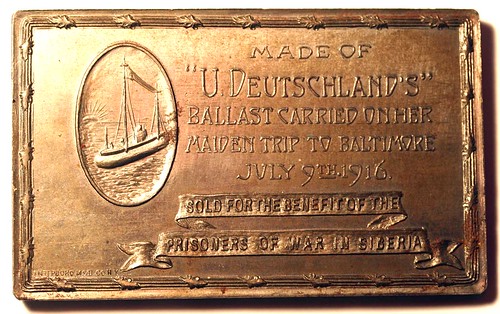
PREV ARTICLE
NEXT ARTICLE
FULL ISSUE
PREV FULL ISSUE
A RELIC MEDAL OF THE GERMAN SUBMARINE DEUTSCHLAND
In last week's Numismatic Diary, I mentioned the June Nummis Nova meeting.
Dave Schenkman was there and he passed around an interesting relic medal. He sent me this image, and a copy of an article he wrote about it for the American Numismatic Association's Numismatist. Thanks!
-Editor

The Deutschland was the first German submarine to cross the Atlantic Ocean. The 790 ton cargo vessel was approximately 230 feet in length, and carried a crew of four officers and twenty-five men. On the surface, her speed was fourteen or fifteen knots; when submerged, it was about half that. Paul Konig, her commanding officer, had not served in the German navy; he was a captain of the North German Lloyd Line, builders of the Deutschland, but because of German law that made him a member of the naval reserve. Konig sailed his vessel for Baltimore on June 18, 1916, carrying a cargo consisting of some "750 tons of medicinal and coal-tar dye products." He successfully eluded the British ships which were patrolling off the coast of Virginia, navigated up the Chesapeake Bay, and entered Baltimore harbor on July 9th. The submarine docked at Locust Point, a peninsula on the west side of the Inner Harbor. At this time, Great Britain was at war with Germany, but the United States had not yet entered the conflict. The purpose of the German submarine's visit to America was to sell her cargo, which had a value of 1.5 million dollars. And, even more importantly, they wanted to purchase strategic war materials such as nickel, rubber, and tin. The Germans were successful on both counts; they sold their merchandise and on August 2nd left Baltimore with a full cargo, much of which was stored outside the submarine's pressurized hull. On October 2nd the Deutschland left Bremen and made her second trip to America. This time her destination was New London, Connecticut, and she arrived there on November 1st. She returned to Germany on November 17th, carrying nearly a thousand tons of nickel, tin, and crude rubber, with an estimated value of two million dollars. There would be no more such trips for the Deutschland. On April 6, 1917, the United States declared war on Germany. The submarine was converted from a cargo vessel for war duty, and was given the designation U-155. During the span of three cruises she sank more than forty ships. Two interesting numismatic items commemorate the submarine's visit to Baltimore. The best known of these is a heavy iron medal in the shape of a cross. It is about 13mm thick and 73mm across. On each side, the date, 9 JULI is at the top, and the year 1916 at the bottom. Inset in the center of each side is a brass medal approximately 29mm in diameter. One of these features Kuhn's bust, with U-DEUTSCHLAND above and PAUL KONIG KAPITAN below. On the other side, the submarine is depicted in the center. The Dove of Peace is in a small oval at the top, with IN BALTIMORE 9 JULI 1916 in two lines on a banner just below it. Around, the inscription is ZUR ERINNERUNG AN DIE ANKUNFT DES ERSTEN HANDELS U-BOOTES, which I believe translates roughly to "in commemoration of the arrival of the first commercial U-boat." One of these medals was sold at a major numismatic auction a couple of years ago and the cataloguer commented that "these were presented to business leaders in the U.S. that the U-boat company wanted to curry favor with for future dealings." The second medal seems to be quite a bit scarcer than the one just described, and not as well known to collectors. It is a 50x82mm rectangular piece, struck in iron on a uniface planchet. The submarine is depicted to the left, within an oval. The seven-line inscription is MADE OF / "U. DEUTSCHLAND'S" / BALLAST CARRIED ON HER / MAIDEN TRIP TO BALTIMORE / JULY 9TH 1916. / SOLD FOR THE BENEFIT OF THE / PRISONERS OF WAR IN SIBERIA (the last two lines are on ribbons). The medal was struck by the Interboro Medal and Badge Manufacturing Co. of New York City, and it is signed at the bottom, in tiny letters, INTERBORO M. & B. CO. NY. These medals are interesting from an historical standpoint. And, from a numismatic standpoint they are popular, as are all "made from" relic medals. THE BOOK BAZARREWayne Homren, Editor The Numismatic Bibliomania Society is a non-profit organization promoting numismatic literature. See our web site at coinbooks.org. To submit items for publication in The E-Sylum, write to the Editor at this address: whomren@gmail.com To subscribe go to: https://my.binhost.com/lists/listinfo/esylum All Rights Reserved. NBS Home Page Contact the NBS webmaster 
|